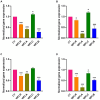Woodfordia fruticosa fermented with lactic acid bacteria impact on foodborne pathogens adhesion and cytokine production in HT-29 cells
- PMID: 38751719
- PMCID: PMC11094545
- DOI: 10.3389/fmicb.2024.1346909
Woodfordia fruticosa fermented with lactic acid bacteria impact on foodborne pathogens adhesion and cytokine production in HT-29 cells
Abstract
Introduction: The study into the interplay between foodborne pathogens and human health, particularly their effects on intestinal cells, is crucial. The importance of lactic acid bacteria (LAB) in promoting a healthy balance of gut microbiota, inhibiting harmful bacteria, and supporting overall gastrointestinal health is becoming more apparent.
Methods: Our study delved into the impact of fermenting Woodfordia fruticosa (WF), a plant known for its antimicrobial properties against gastrointestinal pathogens, with LAB. We focused on the influence of this fermentation process on the binding of foodborne pathogens to the gut lining and cytokine production, aiming to enhance gut health and control foodborne infections in HT-29 cells.
Results and discussion: Post-fermentation, the WF exhibited improved antimicrobial effects when combined with different LAB strains. Remarkably, the LAB-fermented WF (WFLC) substantially decreased the attachment of pathogens such as L. monocytogenes (6.87% ± 0.33%) and V. parahaemolyticus (6.07% ± 0.50%) in comparison to the unfermented control. Furthermore, WFLC was found to upregulate IL-6 production in the presence of pathogens like E. coli O157:H7 (10.6%) and L. monocytogenes (19%), suggesting it may activate immune responses. Thus, LAB-fermented WF emerges as a potential novel strategy for fighting foodborne pathogens, although additional studies are warranted to thoroughly elucidate WF's phytochemical profile and its contribution to these beneficial outcomes.
Keywords: HT-29; Woodfordia fruticosa; fermentation; foodborne pathogens; lactic acid bacteria.
Copyright © 2024 Lee and Lee.
Conflict of interest statement
The authors declare that the research was conducted in the absence of any commercial or financial relationships that could be construed as a potential conflict of interest.
Figures





Similar articles
-
Behavior of Escherichia coli O157:H7 and Listeria monocytogenes during fermentation and storage of camel yogurt.J Dairy Sci. 2016 Mar;99(3):1802-1811. doi: 10.3168/jds.2015-9872. Epub 2015 Dec 24. J Dairy Sci. 2016. PMID: 26723116
-
A Systematic Approach to Identify and Characterize the Effectiveness and Safety of Novel Probiotic Strains to Control Foodborne Pathogens.Front Microbiol. 2019 May 17;10:1108. doi: 10.3389/fmicb.2019.01108. eCollection 2019. Front Microbiol. 2019. PMID: 31156609 Free PMC article.
-
S-layer protein 2 of Lactobacillus crispatus 2029, its structural and immunomodulatory characteristics and roles in protective potential of the whole bacteria against foodborne pathogens.Int J Biol Macromol. 2020 May 1;150:400-412. doi: 10.1016/j.ijbiomac.2020.02.065. Epub 2020 Feb 8. Int J Biol Macromol. 2020. PMID: 32045605
-
Role of Lactic Acid Bacteria in Food Preservation and Safety.Foods. 2022 Apr 28;11(9):1283. doi: 10.3390/foods11091283. Foods. 2022. PMID: 35564005 Free PMC article. Review.
-
Inhibitory Effect of Lactic Acid Bacteria on Foodborne Pathogens: A Review.J Food Prot. 2019 Mar;82(3):441-453. doi: 10.4315/0362-028X.JFP-18-303. J Food Prot. 2019. PMID: 30794461 Review.
Cited by
-
Optimization of fermentation process for Sihuang compound with Bacillus subtilis and its efficacy against Escherichia coli infections and growth performance in broilers.Poult Sci. 2025 Jul 23;104(10):105588. doi: 10.1016/j.psj.2025.105588. Online ahead of print. Poult Sci. 2025. PMID: 40743629 Free PMC article.
References
-
- Bhunia A. K. (2008). General mechanism of pathogenesis for foodborne pathogens. Foodborne Microb Pathog Mech Pathog., 93–112.
LinkOut - more resources
Full Text Sources
Molecular Biology Databases
Miscellaneous

